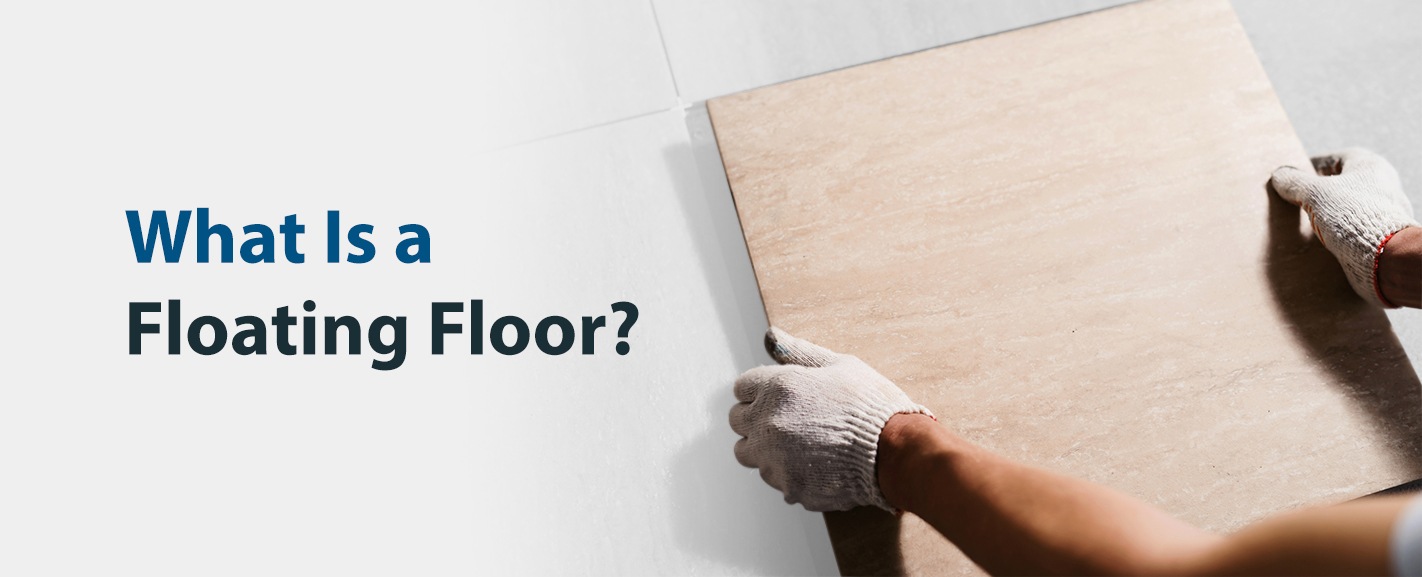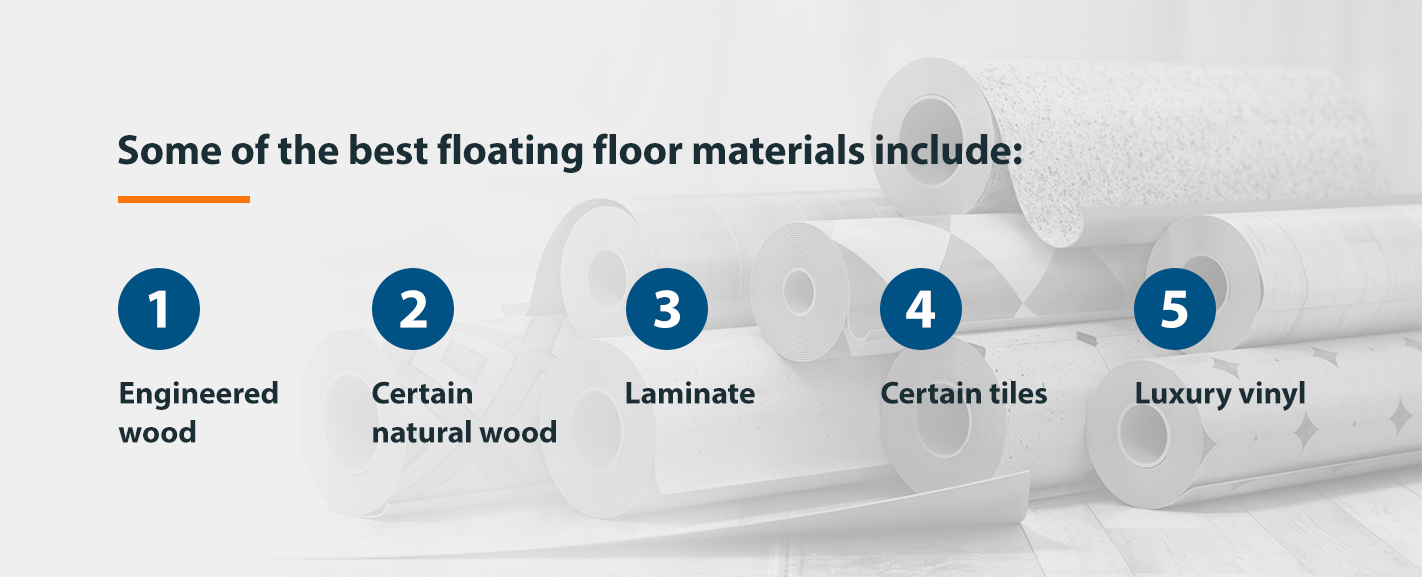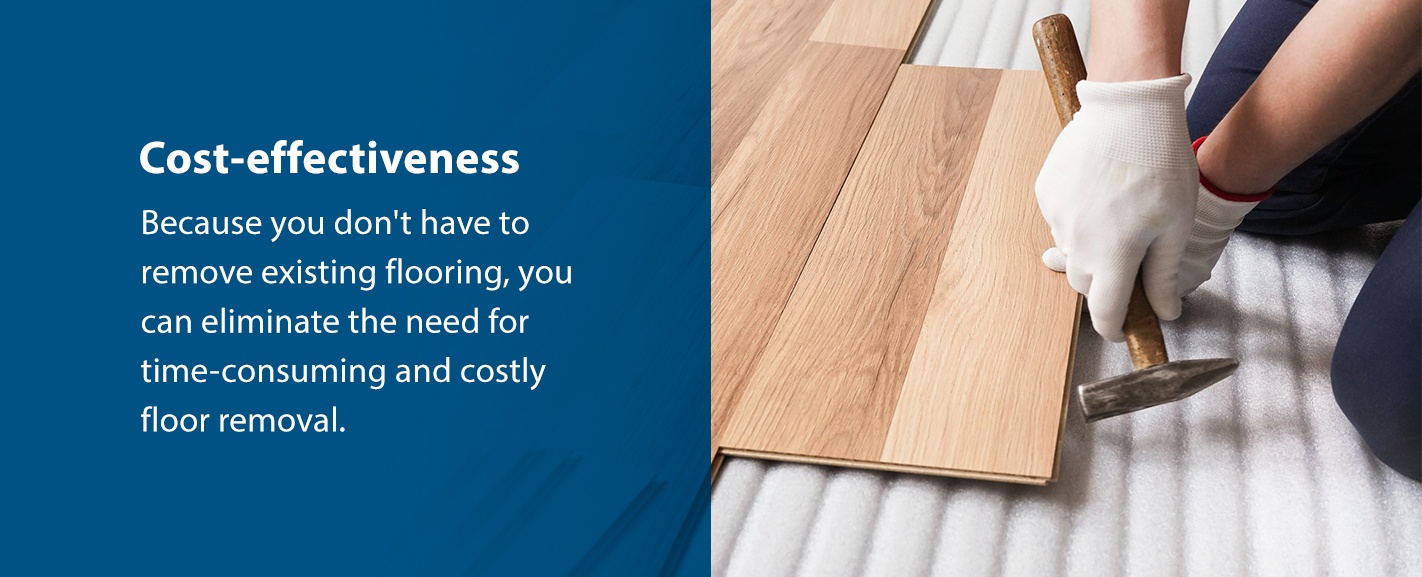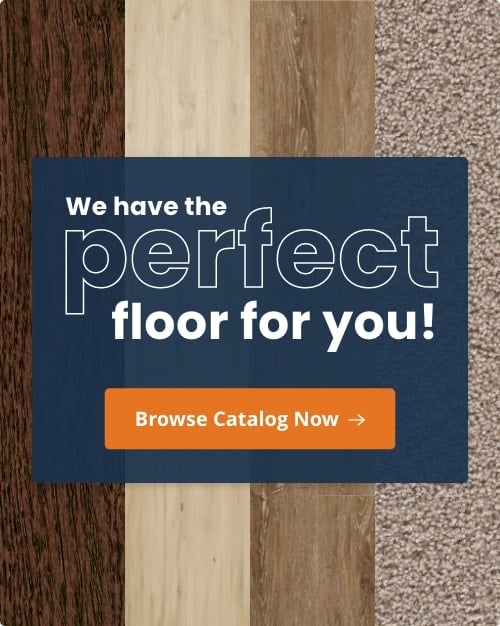

As a homeowner, the type of flooring you choose is extremely important, but so is the method you use to install your flooring—it’s crucial to how well your flooring performs over time. There is more than one approach, but one that is rapidly gaining popularity is floating floor installation.
What is a Floating Floor and How Does it Work?
What does floating a floor mean? While traditional floor installation involves fastening flooring directly to a subfloor with nails or glue, a floating floor is not directly attached to the subfloor. The traditional method requires time-consuming labor and can make it difficult to remove flooring when you want something new. Floating floors, on the other hand, offer a convenient alternative method, interlocking like puzzle pieces to hold themselves in place.
So, what holds down a floating floor? The combination of the interlocking mechanism, the weight of the floor atop a properly prepared subfloor, and properly spaced expansion gaps around the perimeter (usually about 1/4 inch) to allow for temperature and humidity fluctuations all keep a floating floor held down.
What Is Floating Installation for Flooring Like?
One of the advantages of a floating floor is that it is easier to install than traditional flooring. If you’re considering doing it yourself rather than hiring a professional, you might be wondering what the floating floor installation process is like. The assembly includes the following steps:
- Begin by choosing flooring materials that have a manufactured locking system. Consult a flooring professional for advice on what floating floor types and styles will work best for your project.
- Next, you can select a type of underlayment. If you’re unclear on what a floating floor is laid on, an underlayment is a thin sheet of foam or other material that serves as a cushion between the subfloor and flooring. Additional benefits of underlayment include sound dampening and preventing moisture from reaching the subfloor.
- Place the underlayment in the installation area and cut it so that there are several inches of excess up the wall sides.
- Lay tongue and groove flooring on top of the underlaymen, one plank at a time. Secure each piece and fill rows until you reach a stopping point.
- Measure and cut ending planks and affix them in place. As you install, mind baseboards and door thresholds to ensure the transitions are even and there are no gaps.
- When the area is completely covered, trim the excess underlayment and enjoy your new floor.
Laying a floating floor yourself can save money on labor costs, but hiring a professional to install a floated floor will also likely have a lower cost of labor than it would for traditional floor installation. When installing a floating floor, make sure to follow the manufacturer’s instructions. If you think this installation method could be for you, there are several floating floor types you can choose from.
What Are Floating Floors Made Of?
People often ask, “What does a floating floor look like?” The answer is: the same as a traditional floor. The main difference will come from the type of materials you choose. While floating floors began with laminate, today, there are many floating floor types to choose from.
The key requirement for floating a floor is using materials with an interlocking design. This rules out carpet and sheet vinyl but leaves several desirable flooring materials. Though some floating floor materials require glue for installation, many incorporate a design that allows for secure locking without adhesive.


Some of the best materials that can be used for floating a floor include:
- Engineered wood: Unlike natural hardwood, engineered wood is made with layers of wood bonded together with adhesives, heat, and pressure. The resulting material is strong and resistant to humidity and moisture. Choosing engineered hardwood may allow you to enjoy the beauty of wood with a quicker installation process. Most engineered wood is made with a tongue and groove design that allows for a floating installation. This installation will require glue in the seams and straps for installation, which eliminates the need for a locking mechanism to prevent the floor from pulling apart. Some engineered floors may be constructed using a click-lock type of installation, commonly referred to as lock-and-fold flooring, which will help secure your flooring.
- Laminate: Laminate was one of the first materials to be adapted for a floating floor system. As a durable flooring material, laminate can be installed over a variety of subfloors and existing flooring. Laminate planks use a click-lock design to create a secure yet flexible bond that can stand up to a variety of challenges.
- Certain natural wood: Though most natural hardwood requires a traditional installation, some types may have the tongue and groove design for a floating installation. If you opt for natural wood, ensure your installation allows room for the boards to expand and contract.
- Certain tiles: Traditional tile installation requires each piece to be set in mortar and surrounded with grout. This process involves a significant amount of skill and time, which is why floating tiles can be a desirable alternative. Floating tiles use a rubber base and interlock with a tongue and groove system. Though they still require grout, the interlocking system creates uniform spaces for application.
- Luxury vinyl: Luxury vinyl imitates the look of wood or stone with the moisture-resisting benefits of vinyl. Sold as either interlocking planks or tiles, luxury vinyl can float on top of your subfloor and serve as a cost-effective alternative to natural wood or tile.
Pros and Cons of Floating Floors
What is the most durable floating floor? What does a floating floor mean for comfort level? In this section, we’ll take a look at the benefits and drawbacks of different floating floor types. First, the pros:
- Versatility: Your subfloor material isn’t an issue for a floating installation. Whether your subfloor is plywood or concrete, a floating floor installs quickly and easily. You can also float over existing vinyl, tile, or hardwood floors.
- Cost-effectiveness: Because you don’t have to remove existing flooring, you can eliminate the need for time-consuming and costly floor removal.


- Quick installation: The interlocking floating system requires less assembly time, which is convenient for DIY or professional installation.
- Simple installation: Unlike the traditional method, floating flooring installations do not require many specialized tools or skills. If you are moderately handy, you could install this flooring on your own and save money on labor.
- No adhesives: A tongue and groove design eliminates the need to purchase and use flooring adhesives. This can lower the cost of your project and reduce the need for post-installation ventilation.
- Easy replacements: If a specific plank warps or is damaged, you can replace it with minimal hassle. Though quality flooring and proper care can help prevent the need for replacement, floating flooring materials make it easy to switch out individual planks.
- Flexibility: In areas where humidity is a concern, floating flooring can provide vital space for materials to expand and contract.
In addition to its many advantages, a floating floor may have a few disadvantages, including:
- Potential for noise: Some materials may produce a hollow sound when floated without proper underlayment. To avoid noise issues with a floated floor, it may be worthwhile to invest in a soundproofing underlayment. Another way to reduce noise is to choose a wider plank size.
- Potential for wear: Materials made for floating installation can be thinner and designed not to be sanded. This could cause increased wear in extremely high-traffic areas. If you want to float your floor, it may be beneficial to choose a thick material and ensure the installation area doesn’t have excessive foot traffic.
Though it is helpful to weigh the pros and cons of a floating installation, the best way to decide if it may work for you is to talk to a flooring professional.
The Rising Popularity of Floating Floors
Floating floors have become a prime choice for both homeowners and industry professionals due to their convenience, cost-effectiveness, and longevity.
Here’s why floating floors are in high demand:
- Ease of Installation: Unlike traditional flooring, floating floors don’t require a particular kind of subfloor or to be attached directly to the subfloor. This makes the installation process quicker and reduces cost significantly. Its design allows for a straightforward, user-friendly installation, making it an excellent option for DIY enthusiasts.
- Versatility: One of the standout features of floating floors is their versatility. They can be installed at various levels of a building—whether at grade, above grade, or below grade. This flexibility isn’t typically possible with solid flooring options.
- Cost Efficiency: Floating floors are more budget-friendly than many alternatives. In addition to saving on cost of labor, floating floors eliminate the need for costly materials such as mortar, glues, and nails required for ceramic tiles or solid hardwood floors.
- Portability: An exclusive advantage of floating floors is their portability. If you decide to move homes, you can take your flooring with you, making it a one-time investment.
- Advanced Features: Modern floating floors come equipped with sound-dampening technology and Microban anti-mold and mildew treatment, helping to make your home a more pleasant, healthier environment. These floors also adhere to strict environmental standards, including CARF2 and LEED, ensuring they meet eco-friendly building requirements.
- Durability and Maintenance: These floors come with high-quality finishes that are not only resilient but also easy to maintain, ensuring long-lasting appeal and functionality.
- Warranty and Support: Both residential and commercial users benefit from strong warranties that assure durability and service support, enhancing their overall value proposition.
Find Quality Floor Materials at 50Floor
Floating floors combine quality flooring with convenient installation to produce efficient results you love. At 50Floor, we take care to provide this same convenience and quality. We offer a free, in-home consultation so you can browse a variety of floor designs and compare samples with your decor and lighting.
Our experts are equipped to help you choose the best flooring style and installation type for your needs. Schedule your free consultation today!



